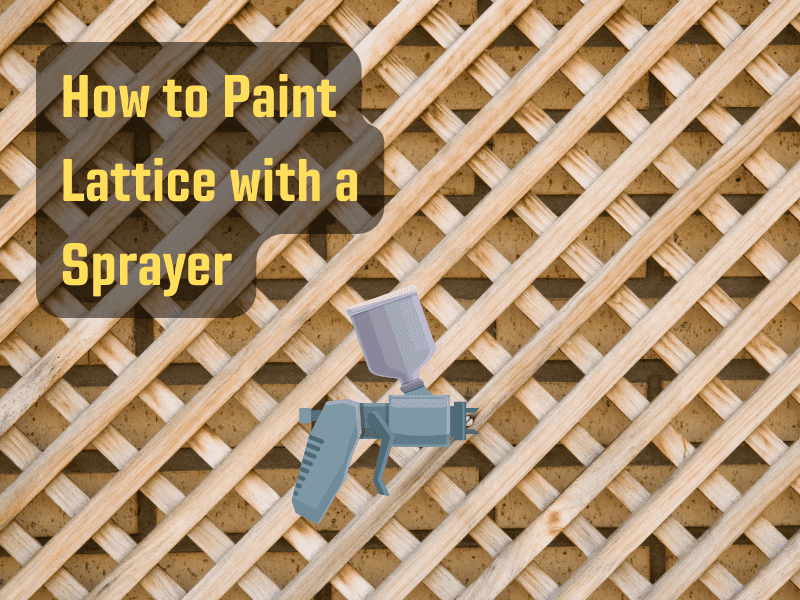Table of Contents
The ‘Why’ Behind the Sprayer
Traditional paint application tools, such as brushes and rollers, have their merits. They can be great for a wide variety of painting projects. However, when it comes to painting a lattice, they can fall short. With their intricate patterns and hard-to-reach corners, lattices present a unique challenge. Brushes and rollers, while perfect for flat, easy-to-reach surfaces, struggle to cover these complicated structures evenly.
That’s where paint sprayers come in. With their ability to disperse paint in a fine mist, they can reach into the nooks and crannies that other tools can’t, ensuring a smooth and even coat of paint. Not only that, but sprayers also allow you to cover a larger area in less time. You can achieve the kind of finish in minutes that might take hours with a brush or roller. This time efficiency is one of the key reasons sprayers are preferred when painting a lattice.
Choosing the Right Sprayer
Paint sprayers come in various types, each with strengths and weaknesses. For lattice painting, there are two types of sprayers that generally work best: High Volume, Low Pressure (HVLP) sprayers, and airless sprayers.
An HVLP sprayer works by forcing a high volume of paint through a small opening at a low pressure. This method of application results in a fine mist that provides precise control and minimal overspray, making it perfect for smaller, more detailed lattice work.
On the other hand, an airless sprayer, as the name suggests, doesn’t use air to atomize the paint. Instead, it pumps the paint at high pressure through a small nozzle. This method provides rapid coverage and a substantial paint capacity, which makes it a good choice for larger lattice projects.
The Importance of Preparation
Like with any painting project, preparation is key when painting a lattice. This process involves three main steps.
- Cleaning: First, clean your lattice thoroughly. This is to ensure that the paint adheres properly and that there’s no dirt or grime that might interfere with the finish. You can use a pressure washer for this step or a simple brush and soapy water for smaller lattice structures.
- Priming: Next, it’s time to prime your lattice. A good primer will seal the lattice’s surface and provide a base for the paint to adhere to. This is especially crucial if you’re painting over a darker color or raw wood.
- Safety Measures: Lastly, protect the surrounding area from paint overspray. You can use drop cloths to cover any plants or furniture nearby and painter’s tape to protect walls or other surfaces you don’t want to paint.
Mastering the Technique
The technique is what separates a mediocre paint job from a great one. Here’s how you can master the technique of painting a lattice with a sprayer.
- Setting the Pressure: Start by setting the sprayer to low pressure. This will give you more control and reduce the risk of overspray.
- Holding the Gun: Hold the gun approximately 10 to 12 inches from the surface. This distance will allow the paint to atomize properly and give you a smooth finish.
- Moving the Hand: Move your hand in smooth, even strokes. Maintaining a consistent speed and distance from the lattice is important to ensure an even coat of paint.
- Applying the Paint: The key to a smooth finish is to apply thin coats. Avoid focusing too long on one area, as this can cause the paint to pool and create drips.
Interlacing Layers
When painting a lattice, you’re essentially painting two sides: the front and the back. It’s important to carefully plan your painting process to ensure a smooth and even finish on both sides.
First, start by painting one side of the lattice. Apply thin, even coats, and make sure to get into all the nooks and crannies. Once you’re done, allow the paint to dry completely before flipping the lattice over to paint the other side. Make sure to also hit the edges and corners from different angles to ensure even coverage.
Cleanup and Maintenance
A well-maintained sprayer will provide consistent performance over time. Here’s how you can clean and maintain your sprayer after a painting job.
- Cleaning: Follow the manufacturer’s instructions for cleaning. Generally, water-based paints can be cleaned with warm water, while oil-based paints may require a solvent.
- Maintenance: Check and replace any worn-out parts regularly. This includes the nozzle, filters, and seals.
- Storage: Store the sprayer in a dry and cool place. Avoid exposing it to extreme temperatures to prevent damage.
Conclusion
Painting a lattice with a sprayer is a task that requires preparation, the right tools, and a good technique. But with these tips and steps at your disposal, you’ll be able to transform your lattice and add a new level of beauty to your outdoor space.
Remember, practice makes perfect, so don’t get discouraged if your first attempt isn’t flawless. With time and patience, you’ll become a pro at lattice painting with a sprayer. So, why wait? Grab your sprayer and start painting!
